Manjusri, et al
Chapter XIV
Once and Future Artists
Ivan Peries’ poetry
Manjusri Thero was the maverick of the ‘43 Group. He was a member from its very inception but strayed from the fold quite easily. By the time of the third exhibition in March 1945, he had resigned from its membership under circumstances that seem to indicate some naivete on his part. There was a suggestion that he had been enticed away by the praise given to him by a British Army officer. John Napper. His exit from the Group was controversial and even dramatic. It was described as a breakaway. It implied disenchantment. The fact that he had left the Group after it had launched him caused some sadness at the time. However, none of this impinged on Manjusri’s own development and later achievement as an artist and a scholar.
His scholarship began when he entered the order of Buddhist monks, at the age of thirteen, in the simple belief that he could, literally, learn to fly. He studied Sinhala, Pali and Sanskrit, and Bengali instead, and went to Shantiniketan to learn Chinese in the course of his studies on the translation of Buddhist texts. At Shantiniketan he met Nandalal Bose who introduced him to painting. On his return to Sri Lanka in 1934, Manjusri started to make copies of Buddhist temple murals. These he took back with him to Shantiniketan where they were exhibited together with some of Rabindranath Tugore’s own work. It was here too that Manjusri was to meet Harry Pieris. Manjusri later travelled up the slopes of the Himalayas to Guntok to study Tibetan iconography. There he met Uchima, the artist of the Tushi Lama. Manjusri returned to Sri Lanka in 1937 and continued the task of making copies of temple murals while producing his own original work as well. He favoured the use of water colour which he used meticulously, working slowly. It was in these early days of venturing into obscure parts of the country that he discovered a fresco fragment dating from the second century BC at Karambagala in the Yala jungles. This was in 1942 while he was still very much a member of the community of monks at Gotami Vihare in Borella. This was where George Keyt had, between 1939 and 1940, completed the murals of the life of the Buddha. Manjusri himself had embellished these murals with decorative panels. These associations and his friendship with Harry Pieris led to Manjusri being invited to become one of the founder-members of the ‘43 Group.
It was at the Gotami Vihare that I first met the paintermonk. Manjusri did not think the notion of a monk who was also an artist in the least incongruous though the Vinaya, the rules governing the conduct of a bhikkhu, prohibited a monk’s indulgence in this kind of activity. He had a way of justifying himself in this regard and with regard to some other tendencies which would be considered unorthodox and unbecoming of a Buddhist monk. But there were ideals too which he held very dear, ideals that as a member of the Sangha he had acquired and which he continued to observe throughout his life.
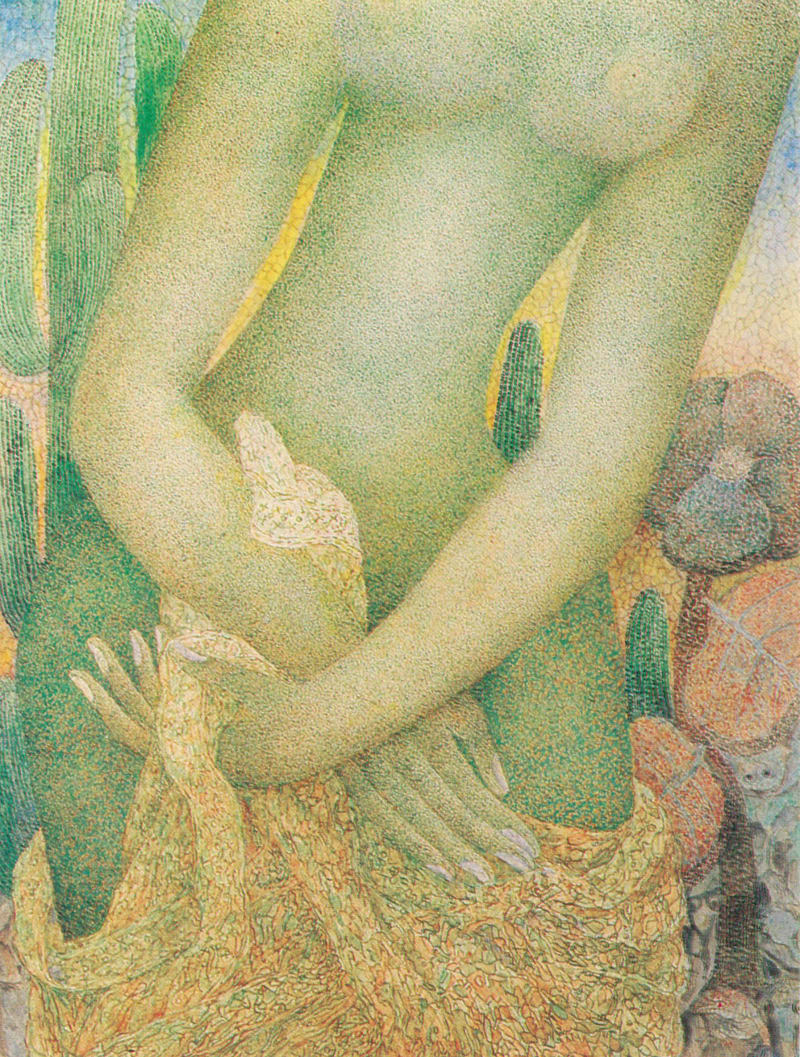
MANJUSRI: Female figure. Water colour on paper (33cm x 44.8cm)
Seeing no contradiction in this, he executed some delightfully Freudian paintings. He remained quite unabashed at some aspects of these whimsical images and justified them also as being the product of his own experience and of the psychological state in which he found himself. They were rare and fascinating pieces of work, impossible to categorise or even describe. Superficially you may have said they may have been influenced by certain modern European painters: Paul Klee perhaps, or even Bruegel or Heironymous Bosch. However, it could also be asserted fairly firmly that Manjusri did not need, nor did he have, access to reproductions of these artists. He had discovered his own images and evolved his individual method and style. Manjusri’s sources were private, very personal; and conditioned by his milieu – the monastery, the ritual, the discipline and the morality of his chosen vocation – and moulded by his own maverick personality.
At the end of 1947, Manjusri went to England and in 1948 held an exhibition in London of mural copies and original paintings, which was opened by Sir Herbert Read. Later that same year, he went to Austria where he had exhibitions in Vienna and elsewhere while recuperating from an illness. When he returned to Sri Lanka in 1949 a local newspaper published a photograph taken of him in secular clothes on board the P & O liner on which he had travelled, thus precipitating a decision he had no intention of taking at that time. The Ven Manjusri Thero reverted to the lay life to become, henceforth, L. T. Pieris, but he retained the monastic name of Manjusri.
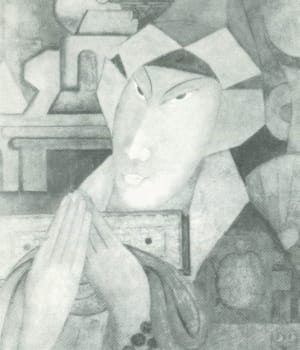
MANJUSRI: The Monk. Water colour on paper.
L. T. P. Manjusri thereafter became a journalist, first on the Lankadeepa, the Sinhala daily, followed by some twelve years of writing in Sinhala for the Silumina and the Janata, and in English for the Observer and the Daily News, publications belonging to the Associated Newspapers at Lake House. In 1977 the Archeological Society of Sri Lanka published his book. Decorative Elements From Sri Lankan Temple Paintings, and in 1981 he was awarded an honorary doctorate by the Peradeniya University. He was awarded the Ramon Magsaysay prize in 1979. (Manjusri married in 1955 and his son Kushaan has followed in his father’s footsteps, earning a reputation as an impeccable copyist and restorer of temple paintings.) Manjusri’s work as a painter has been acquired by the New York Public Library, the Horniman Museum, the Vienna Museum, and for numerous private collections, the most notable being that of Ann Mitchell in London. He also designed a classical figure of Maya, the personification of illusion in Hindu mythology, which was engraved in Steuben crystal. (A drawing by George Keyt was also thus preserved in Steuben crystal, the product of an American enterprise). In all these activities – and it is impossible to distinguish the artist from the scholar – Manjusri fulfilled some of the intentions to which the ‘43 Group had dedicated itself. The pity of it was that Manjusri chose not to pursue these ideals in the company of this community of artists.
And others
Several other painters were associated with the Group and exhibited with it as members. Still others exhibited their work by invitation. They bear witness to the encouragement offered to them by the Group in the pursuit of its objectives. For longer or shorter periods, for better or for worse as it were, the Group took unto itself a large number of people who wished to participate in the arts of painting or sculpture. They are named here alphabetically.
- Harischandra Noel Abeyasinghe had a portrait study at the tenth exhibition of the Group in December 1955. While an architecture student in Melbourne, he exhibited at the Richman Galleries. Arnold Shore in The Age said his Family Group, a panel, was “delightfully simple in colour and line, (and) has something of mural quality.” Abeyasinghe exhibited with the Group in the Purcell Room Foyer of the Royal Festival Hall, London, in October 1985. He has exhibited elsewhere as well. In a note to the Purcell Room exhibition, Ivan Peries said that Abeyasinghe was one of the most brilliant of a “hand-picked bunch of the best painters around” when he taught them at the Melbourne Art Classes in 1950.
- Edmund Blacker was a sculptor who had three pieces at the Group’s Wendt commemmorative exhibition. Elisa, The Litter, and Roslyn were “some of the best seen locally for a long time,” and were noted by one of the critics as “strikingly composed and finished.” He was well received the following year for his Portrait of a Cynic. In 1945, another critic enjoyed the “tender modelling” of Cecilia.
- Of R. S. R. Candappa, a critic wrote that his “sole exhibit (Manjusri Thero) is a delightful and spontaneous bit of work” and that “one would like to see more of this artist.” There were, in fact, two pictures by Candappa at this 1945 exhibition. Reggie Candappa is of course, the advertising man and graphic artist.
- Ralph Claessen, a sculptor who exhibited at the inaugural exhibition was to continue his association with the Group for a few years. His work was described, like Blacker’s, as “strikingly composed and finished.” At the fourth exhibition, a reviewer found his work in lead, chalk and clay “a credit to this department. There is obvious sincerity about his work.” He migrated to Australia in 1948, and died in Melbourne in 1987.
- Gordon Davey’s Country Women was considered the best of the work of the newcomers at the second Group show. Tori de Sousa found it “a skilful piece of work.” However, said L. P. Goonetilleke, his “book-cover illustrative instincts sometimes gets the better of him.” Davey was a serviceman.
- Ranjit Fernando was one of the products of Aubrey Collette’s art classes at Royal College but latterly was self-taught. Fernando was entirely responsible for the exhibitions of the Group abroad beginning in London in 1952 with the exhibition held under the auspices of the India, Pakistan and Ceylon Society at the Imperial Institute in South Kensington, and followed by exhibitions in Paris, Venice, Sao Paulo and Cambridge. One of his more ambitious projects, organised with William Graham, was an exhibition held from 23 October to 19 November 1960 at London’s Ceylon Tea Centre gallery called Ceylon: A Painter’s Country to “illustrate the practice ot painting in Ceylon from the fifth century to the present day.” Sir Herbert Read provided the Preface to the catalogue, which also contained an Introduction by William Graham. Of his work as a painter the Manchester Guardian critic said: “two of his landscapes are painted in such a joyous, clear rush of wind that they tumble over themselves like waves in a seascape. Fernando is one of the youngest members of the Group but he already seems to know where he is going.” Michael Middleton in The Spectator on 12 December 1952 found that Fernando’s “fluent, gentle, semi-abstracted landscapes in soft, light greens” seemed “to be purely personal and free of particular influence.” On his return to Sri Lanka, Ranjit Fernando taught at Cora Abraham’s art classes before abandoning painting. The 1955 show at the K. V. G. de Silva bookshop in Bambalapitiya had Mervyn de Silva ecstatic over “the lyric delicacy of a painting by Ranjit Fernando called House Under Snow.” He had five pictures in the ninth exhibition of the Group in March 1955. Fernando has recently edited and published a book called The Unanimous Tradition – Essays on the Essential Unity of All Religions.
- Ivan M. Fernando’s work was seen at the second exhibition of the Group in July 1944. L.P.Goonetilleke found “promise” in a “delightful picture entitled Mother and Child.”
- Sushila Fernando was a newcomer in 1955. She studied first under Stanley Abeysinghe in Colombo before taking lessons at the St Martin’s School of Art, London. She exhibited with the Group in Cambridge. Her “canvases are well composed and display some incredibly lovely colour. There is a slight feeling of superficiality, however, probably due to the over-abstracted forms which lack human interest in spite of solid draughtsmanship,” wrote Aubrey Collette.
- Donald Friend, the Australian artist was living in Bentota as a guest of Bevis Bawa when he was invited to exhibit with the Group in 1959.
- Susan Foster Greene, an American graphic artist then living in Colombo, was invited to show a group of six pictures at the 1959 exhibition.
- Pieter Guerney, sculptor, exhibited a piece entitled Torso which a critic described as excellent at the Group’s second exhibition.
- Chitranthani Gunasekera exhibited by invitation in 1964. Her preference for light blues and greens and purples was “easy on the eye” said the Times of Ceylon critic.
- Ashley Halpe had three pieces at the Group exhibition at the Imperial lnstitute 1952.
- Nalini Jayasuriya was invited to show ceramics at the tenth exhibition in 1955.
- Swarnee Jayawardene, a pupil of Harry Pieris, exhibited with the Group in 1954, and her “luminous style” drew the attention of Fred de Silva of the Times of Ceylon.
- Terry Jonklaas. A newcomer in 1945, one critic said his work had “a definite bias for the macabre and a certain cynicism … the bold and carefree technique is quite exciting.” Another newspaper comment was that he was “aiming at a sophistication which is not his as yet:’ His 1947 showing was more generously received: “Terry Jonklaas has made the most even contribution and had five works of high merit.” However, by the seventh exhibition, Tori de Sousa of the Times of Ceylon had become disenchanted. Jonklaas’ recent work, he said, “belies his early promise.”
- K. Kanagasabapathy was included in the exhibition to commemorate Lionel Wendt in 1945.
- S. R. Kanakasabai, a protege of Geoff Beling and inspector of art for the Northern Provice, exhibited at the second ‘43 Group exhibition. He returned to the fold after an absence of many years to exhibit with the Group in 1948 with a single painting called Black Out.
- Sybil Keyt, married to Neville Weereratne, was invited in May 1956 to exhibit with the Group, and was one of the painters seen at the Ceylon: A Painter’s Country exhibition in London in 1960. A founder-member of the Young Artists Group, she has exhibited regularly with it since its inception in May 1957. She was also included in the Asian Artists exhibition in Toyko in 1958. She joined Neville Weereratne in an exhibition sponsored by the Lionel Wendt Arts Centre in 1967, and had a solo exhibition at the Samudra Gallery in 1970. She moved to Melbourne with her husband in 1971 and had a joint exhibition with him at the Highway Gallery in 1991. Sybil Keyt also took part in a series of studio exhibitions in Colombo with Sita Kulasekera, Richard Gabriel, Manjusri and others, between 1962 and 1964.
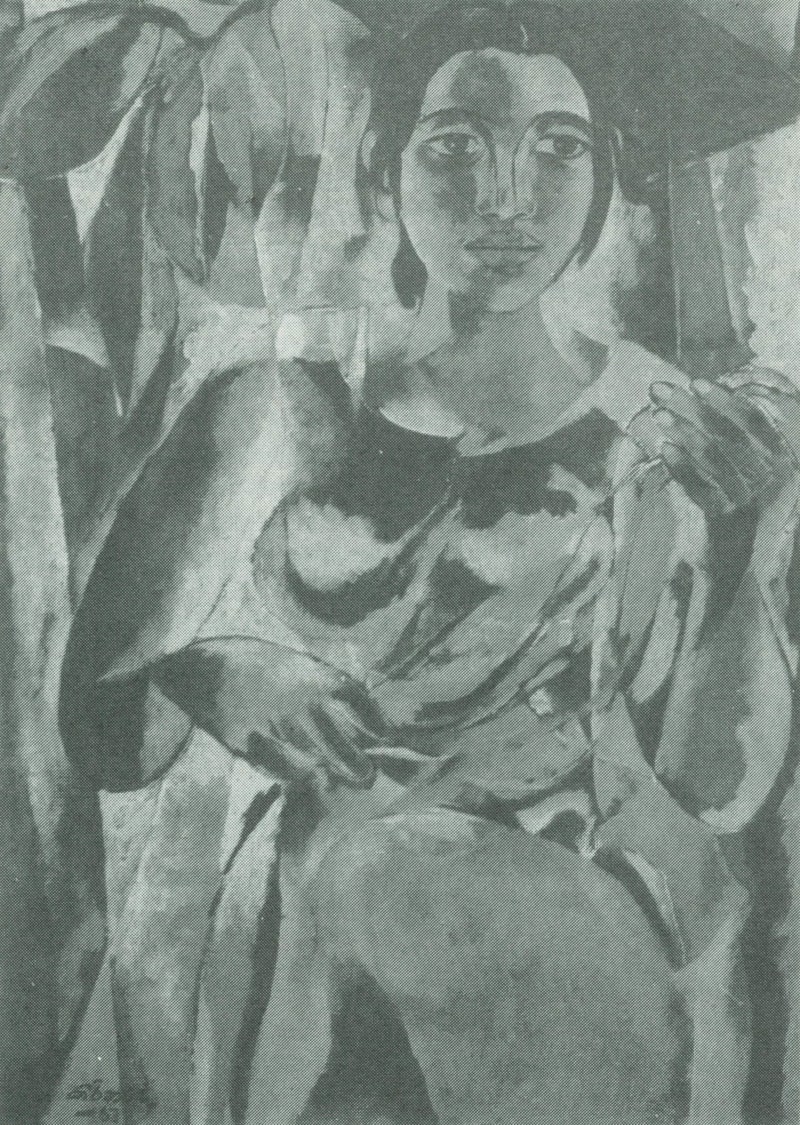
STANLEY KIRINDE: Woman Draping her Saree. Oil on hardboard (45cm x 60cm). Anton Wickremasinghe Collection
- Stanley Kirinde had three paintings in the ninth exhibition in March 1955 and five at the tenth. Aubrey Collette saw signs of the good things to come in a piece he wrote on the March 1955 exhibition. Since then Kirinde has painted himself into a splendid profile exhibiting regularly with the Group and being given the distinction of a one-man show by the Sapumal Foundation in May 1983. Ian Goonetileke, introducing the exhibition said that with these pictures Kirinde entered “without dispute the ranks of Sri Lanka’s major painters having matured in measured and confident degree in the last three decades … His unabashed sympathy for common people in their settings continues unabated, and their preoccupations, moods, and physical attitudes are depicted with a sure eye and a constant hand. Brooding sadness and significant gesture are conveyed with affection and candour alike, and landscape provides an impressive outlet for his love of nature.”
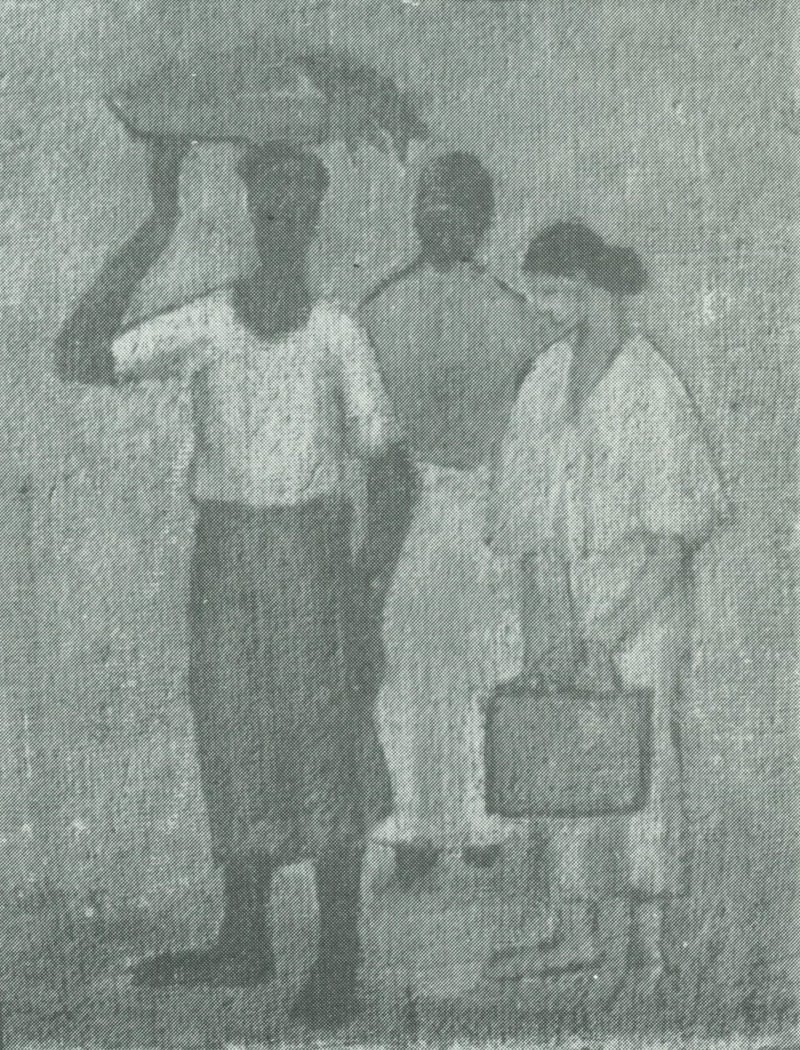
SITA KULASEKERA: Figures. Oil on canvas (29cm x 38cm). Hiran & Rene Leitan Collection, Melbourne
- Sita Kulasekera, married to Richard Gabriel, exhibited with the Group in London at the Imperial Institute in 1952, and regularly thereafter for a number of years. Hers were quiet, restrained paintings. Fred de Silva writing on the ninth exhibition in 1955 found a study of horses “among my pleasanter memories of the show.” At the fourteenth exhibition, the Times of Ceylon critic found appealing “the excellent portraiture – a young boy and a girl – and the black-and-white women” by Sita Kulasekera. She also joined Gabriel, Manjusri and others in studio exhibitions between 1962 and 1964.
- Wyndham (Taffy) Lloyd, a mercantile executive had lived in Sri Lanka since 1930 and taught himself painting. He exhibited by invitation in October 1959.
- Edith Ludowyk showed tapestries by invitation at the tenth exhibition.
- Marie Perera, a founder-member of the Young Artists Group, was invited to exhibit an embroidered tapestry at the May 1955 exhibition.
- P. Premachandra exhibit;ed at the Group’s fourth exhibition in 1945.
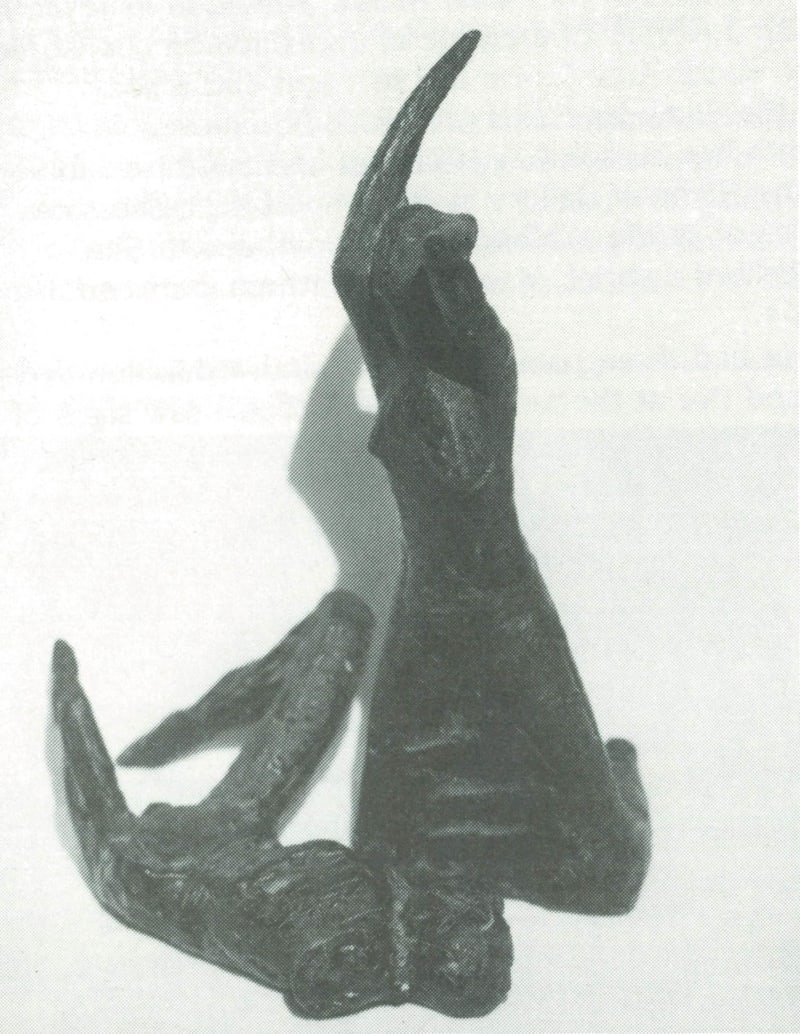
TISSA RANASINGHE: Race riots memorial project, 1958. Bronze. Private Collection. Photography by Amahl Weereratne.
- Tissa Ranasinghe exhibited by invitation in 1964. Though not a member of the Group at any time, he was very highly regarded by all. Aubrey Collette, for instance, supported the appeal launched in the Ceylon Observer in November 1959 to transport Ranasinghe’s “excellent statue of D. S. Senanayake to Ceylon so that it could replace the effigy that now stands in front of the Houses of Parliament.” In the Daily News review of 31 July 1965, I was able to say of Ranasinghe that several hundred years had to pass before an articulate sculptor was born in Sri Lanka. “Tissa Ranasinghe’s antecedents are lsurumuniya and Yapahuva and Anuradhapura and Polonnaruva. Here indeed, is the finest growth of a mind totally aware of the heritage, and a responsibility sufficiently humble to contain no more than a simple memory of these things.” He now lives and works in England.
- William Roberts exhibited in 1947. He had an arresting and meticulously drawn portrait entitled Kumari, but one of the reviewers questioned why it should have been shown at all.
- Shelton Thabrew exhibited in 1964. One of the comments of the time was that he had been influenced by Donald Friend, the Australian artist who was then living in Bentota.
- Chandra Thenuwara was also a member of the Young Artists Group. She had three paintings at the December 1955 exhibition.
- Yolvin J. Thuring, a pupil of Justin Daraniyagala, exhibited at the inaugural exhibition of the Group by invitation. He did not continue this association and was to migrate to Australia in 1970 where he held a one-man exhibition at the Victorian Artists Society galleries in Albert Street. East Melbourne in 1973.
- Gamini Warnasuriya, an architect, was a pupil of Aubrey Collette at Royal College. He produced most engaging and whimsical compositions, of a highly decorative nature in the main, and had a fine command of line and colour. Among his most successful work was a portrait of the young pianist Jean White, and a mural he executed for the Ceylon Tea Centre in Melbourne. While still a student, he held a one-man show in Melbourne’s Richman Art Galleries which a critic on The Age described as the best at that gallery up to that time. Arnold Shore wrote: “This artist, sent to the University of Melbourne to study architecture has already something of an international reputation, and his style compounds something of European contemporary (art) with a keen sense of his own national tradition. There is much in his work that is quite eastern, suggesting the art of both India and Persia.” A reviewer in the Times of Ceylon of the fourteenth exhibition of the Group in January 1964 remarked that Warnasuriya was exhibiting after a long time, and stated that “every one of his paintings, with their figures so reminiscent of ancient Egypt is striking.” Mervyn de Silva found his work the most attractive of those of the younger members of the Group at the K. V. G. de Silva exhibition in 1955. Since completing his studies in architecture, Warnasuriya has lived in Perth, Western Australia.
- Nalini Wijenaike. She had a “pleasant” still life at the seventh exhibition; it was also described as “a quiet but elegant flowerpiece.”
- Walter Witharne was among those invited to exhibit at the inauguration of the ‘43 Group. Critical comment of his work at the time was that he had a traditional view of the Sabaragamuva landscape, which was described as “charming and pretty.” He was still found to be painting “pretty” pictures at the Wendt commemorative exhibition in 1945. His work was bold, “but not bold enough.”
- Ahmed ben Driss el Yacoubi was a Moroccan painter visiting Sri Lanka in the company of the American novelist, Paul Bowles.
- And myself, Neville Weereratne.
In her review of the ‘43 Group in The Arts of Asia (MarchApril 1986) Ellen Dissanayake said that more than forty hopeful artists made their appearance with the ‘43 Group at one time or another. Bar just a very few, most of these have abandoned painting and, but for these exhibitions, may not have had the opportunity to test themselves with the dignity the ‘43 Group offered them.